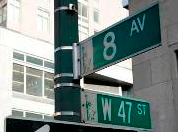
As always, The Elliman Report released earlier this month provided a wealth of data on the state of the Manhattan real estate market. In many cases, the overall trends were not particularly surprising, with average prices maintaining their upward trajectory and vacancy rates remaining low. Still, when breaking down the numbers by specific neighborhoods, there are some interesting fluctuations from last year’s numbers worth noting.
Looking at all of Manhattan, it’s clear that average rent has continued its steady rise, with the median rental price jumping 6.5% from last year’s $3,000 to $3,195. The number of new rentals rose to 4,287, a small increase of 1.4% from last April. When combined with a low vacancy rate of 1.58% (exactly the same as April 2012) one can surmise that renewals have risen as “tenants and landlords become more in sync with actual market conditions.”
When breaking down the numbers from specific districts, a clearer picture begins to emerge. In Downtown, a sharp rise in the popularity of larger units (2-bedrooms and 3+ bedrooms) caused an 8.8% rise in average rental price, compared to only a 3.5% increase in median rental price from last April. Small declines in new rentals (2.6%) and in vacancy rate (.07%) also suggest higher rates of renewals as tenants are more hesitant to let go of their current apartments.
On the East Side, rentals spiked up 22.5% from prior year levels, with most of the gains taking place in larger apartments. Rentals of 2-bedrooms and 3+ bedrooms rose by 58.7% and 33.8%, respectively, “a sign of greater resistance to rental increases at time of lease renewal,” which goes against the overall trend of complacency we see across the rest of Manhattan. Pricing indicators were varied, with median rental price increasing 5% and the average rental price falling 6.4%. The vacancy rate was much more clear cut, with the East side maintaining the lowest vacancy rate in Manhattan by falling from 1.86% last year to 1.04%.
The West Side bucked the trend of new rentals, dropping 2.4% from last April. Only 3+ bedrooms posted a positive gain, rising slightly by 3%. Prices were also varied here as median rental prices increased by 1.8%, but many other categories saw declines. Average rental prices and average rental prices per square foot fell 3.8% and a hefty 9%. Studios and one bedrooms saw small increases in average rent while 2 and 3+ bedrooms fell by 14.0% and 7.6%. Rental prices per square foot for 3+ bedrooms fell a drastic 25.6%. The West Side also featured the highest vacancy rate in all of Manhattan, rising from 1.57% in April 2012 to 2.22% in 2013.
New rentals in Uptown dropped a dramatic 41.7% over the last year, with all apartment sizes posting double-digit drops. Median rental prices rose across the board, while the overall average rental price rose 18.3% to $2,357. In contrast, rental price by square foot increased by a mere 0.9%, with studios falling by a whopping 35.5%. The vacancy rate also climbed to 1.86% from last year’s 1.42%.
Despite varied pricing indicators, Jonathan Miller, appraiser and a preparer of the report, noted that the rate of price increases was generally consistent across all unit sizes. According to Miller, the reason for this is the same as it always was, with rising employment and limited credit to blame. Those who would have qualified for loans years ago are being forced to remain in the rental market. Still, the purchase market remains strong, despite the lack of credit.
In a report on Curbed, Miller also observed that new rental activity is far more modest than in the past, but landlord concessions (reduced rent or fees, shorter lease periods, etc.) are still limited. This has led to a higher number of lease renewals as landlords are cooling off price increases to stay in sync with the market. In other words, if the rent is high everywhere, and the high demand and historically low vacancy rates means you’re not likely to get many concessions, there is little incentive to go through the hassle of finding a new apartment.
In light of these numbers, there are several things apartment hunters can do to navigate the frantic market. For one, don’t expect prices to go down anytime soon. Annual trends show no signs that the steady increases in rent will change, and rents in summer are always higher than the rest of the year. With high rents and low vacancy rates, apartment seekers need to move as quickly as possible to seize every opportunity. Contact us now for assistance in finding your perfect New York apartment.





